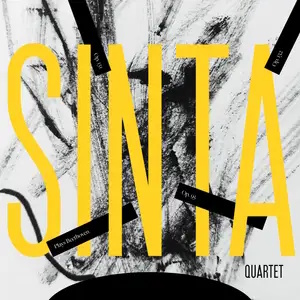
Ludwig van Beethoven (1770-1827)
String Quartet No. 11 in F minor, op.95, “Serioso” (1814)
String Quartet No. 15 in A minor, op.132, third movement (1825)
String Quartet No. 14 in C-sharp minor, op.131 (1826)
Sinta Quartet (saxophones)
rec. 2022, Solid Sound, Ann Arbor, USA
Bright Shiny Things BSTC-0196 [78]
I am always a sucker for someone doing something completely different with Beethoven’s works, and this disc of string quartet selections transcribed for saxophone quartet fits the bill. The Sinta Quartet presents new, never-before-recorded arrangements of some of Beethoven’s works for the string quartet that often come across quite beautifully and with an earthy quality that is quite different from the originals but still carries a powerful emotional content.
The quartet uses a soprano, alto, tenor and baritone saxophone on these pieces. There had to be significant reworking of the originals here, especially since the baritone sax, while it can reach down to the lowest cello note, is helpless in the higher registers, being afforded only a two and one-half octave range, as opposed to the cello’s four octaves. The soprano sax is thus frequently called upon to take over the stratospheric parts of the cello, which results in a very different timbre effect. And obviously, saxes are unable to handle double stops where Beethoven writes them, though on occasion that is handled by dropping from the top note to the lower one in a minor cheat. There’s an interesting advantage to these arrangements, since two violins are often indistinguishable; there is no confusing a soprano and alto sax, making the lines of each quite a bit easier to pick out for the determined listener.
The quartets selected here are all in a minor key, which is befitting for the sensitive and often mournful sound of a sax ensemble. The first work on the disc is the so-called “Serioso,” op.95 in F minor. Early on in this arrangement, we see the advantage of saxophones in the triplets in the middle voices of the first movement, which in their fluidity are entirely suited to the sax voicing. The baritone sax is quite beautiful in the second movement as it renders the descending walking bass that lays the foundation for the upper voices. The sax tone is likewise delightful in the Allegro assai vivace ma serioso third movement that gives the quartet its nickname. The octave leaps in the final movement do sound a bit more comical than they really should, however. The molto leggiero ending is surprisingly delicate and light.
The third movement of the op.132 quartet follows, or as Beethoven named it, the Heiliger Dankgesang, or Holy Song of Thanksgiving of a Convalescent to the Godhead, in the Lydian Mode. This movement was conceived after the quartet was well under way, and reflects a serious inflammation of the intestines that Beethoven suffered in April and early May of 1825, rendering him incapable of working. Only upon moving to the countryside was Beethoven able to resume work on this quartet. The tempo Beethoven indicates is Molto adagio, and it is very slow here indeed, running nearly 17 and one-half minutes. The Sinta Quartet is at their best here, with beautiful phrasing and admirable breath control. The section entitled “Feeling New Strength” is delicately joyous, and the whole is both sensitive and subtle.
Finally, the Sinta Quartet tackles what is to my mind one of the most difficult of Beethoven’s works to understand, the quartet #14 in C-sharp minor, op.131. I’d also note that C-sharp minor is hardly the easiest key for saxophones in B-flat and E-flat to play. This mysterious and abstract quartet unfortunately gets no new light shone upon it here, but it is nonetheless smoothly and delicately played, especially in the many moments of quirky momentary swelling and collapsing on a note. These quick crescendo/decrescendos are quite effective on the saxophone, which can really make the most of them. The fourth movement includes some wonderful moments for the baritone sax, just oozing with good humor. The quartet also features a number of pizzicato notes; it’s not entirely clear to me how those are accomplished here but they seem to be lightly voiced with tapping on the instrument. The last few movements are a real highlight: the fifth movement Presto is a lot of fun, while the sixth movement Adagio is highly expressive and emotional. The work concludes with an Allegro that is very effective, though the high B in the original can be a little painfully harsh if not a bit flat here in the hands of the soprano sax.
Although these pieces do not have very many repeats designated by Beethoven, Sinta Quartet faithfully observes them all, to their credit.
The recording quality is exceptional. There is no evidence of dynamic compression being used, and the reverb of the studio makes for a lovely decay of the saxophone sounds. The atmosphere is simply luscious.
While these recordings are of course no substitute for the real thing, they are definitely worth a listen. There are even moments where the saxes can outshine the strings, especially in moments of subtlety.
Mark S. Zimmer
Mark S. Zimmer is the Project Director of The Unheard Beethoven website and writes a daily column on what Beethoven was doing 200 years ago today.
Buying this recording via a link below generates revenue for MWI, which helps the site remain free



















